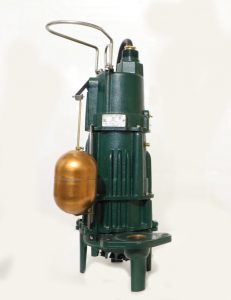PumpProducts.com carries explosion proof pumps from top manufacturers such as Goulds, Zoeller, and Liberty.
What is An Explosion Proof Pump?

Explosion proof pumps are made to operate in hazardous areas, loosely defined as areas where: (1) electrical equipment is operating and (2) flammable vapors are present in the air. Naturally, such areas carry the risk of a spark from the equipment igniting a vapor and causing an explosion. The National Electric Code (NEC) and the National Fire Protection Agency (NFPA) categorize hazardous areas into a variety of Classes, Divisions, Zones, and Groups depending on the specific variables in the environment.
Typical hazardous areas include oil refineries, chemical processing plants, mines, and factories. Hazardous area designation is not restricted to heavy industrial areas. For instance, gas station bathrooms often use explosion proof sewage pumps because of their proximity to a gas tank.
Explosion proof pumps are constructed to prevent the creation of sparks, to contain the pressure should an explosion occur, and to prevent the explosion from spreading outside the pump itself. This is accomplished in a variety of ways. The motor enclosure is generally made of thick, strong materials and is usually watertight and dust tight. Stainless steel seals are often used to secure the enclosure.
Non sparking materials, such as bronze, brass, and thermoplastic, are used in the construction. Non sparking alloy composites of ferrous metals (iron, steel) can also be used.
Explosion proof pumps encompass a wide range of pump applications, including sewage, grinder, sump, and effluent applications. General centrifugal pump types are available as well.
Zoeller MX161 161-0106 Explosion Proof Effluent Pump
Part of the innovative X160 series, the Zoeller 161-0106 can be used for either residential or commercial dewatering/effluent applications in Class 1, Division 1, Group C, and D* environments. This pump is durable and built to withstand harsh environments. The cover, motor adapter, and pump housing are all class 30 cast iron.
The shaft seal is composed of stainless steel wetted parts, carbon, and ceramic, while the float is non-ferrous brass.
Performance-wise, the 161-0106 is built for high head residential and commercial effluent/dewatering applications. The pump operates at ½ HP, 115 volts, and single phase power. The maximum flow rate is 100 GPM, while the maximum TDH is 56 ft.
The discharge is 1-½” NPT threaded, with an option for a flanged discharge attachment. The power cord is 25 ft. with five bare lead wires. All in all, this is an excellent pump that will perform well for any effluent or dewatering application in a hazardous area.
*And now a brief word on hazardous areas, as defined by the NEC and NFPA:
Class I, Division 1: There are three different situations that could exist to classify an area as a Class I, Division 1 location:
–Ignitable concentrations of flammable gases or vapors may exist under normal operating conditions.
–Ignitable concentrations of such gases or vapors may exist frequently because of repair or maintenance operations or because of leakage.
–Breakdown or faulty operation of equipment or processes might release ignitable concentrations of flammable gases or vapors, and might also cause simultaneous failure of electric equipment.
Group C: Flammable gas, flammable liquid-produced vapor or combustible liquid-produced vapor mixed with air that may burn or explode, having either a maximum experimental safe gap (MESG) value greater than or equal to 0.45mm or less than 0.75mm, or minimum igniting current ratio (MIC ratio) greater than 0.40 and less than or equal to 0.80. Example: Ethylene – 497:3.3.5.1.3.
Group D: Flammable gas, flammable liquid-produced vapor or combustible liquid-produced vapor mixed with air that may burn or explode, having either a maximum experimental safe gap (MESG) value greater than or equal to 0.75mm or minimum igniting current ratio (MIC ratio) greater than 0.80. Example: Propane – 497:3.3.5.1.4.
Explosion Proof Control Panels
It is not enough to buy an explosion proof pump and drop it in a pit. All the attendant equipment must also be classified “intrinsically safe,” meaning the electrical and thermal energy is limited to prevent potential ignition. The most important component of the system is the control panel which will cycle the pump.
In addition to being intrinsically safe, the control panel must be compatible with the specific explosion proof pump being used and must be designated for use in the same hazardous area classification.
The control panel that goes with the M161X is the Zoeller 10-1242 simplex panel. The standard panel is UL listed and features a variety of safety and operational features, including pump run lights, a high water alarm (audio and visual), and seal fail indicators. Intrinsically safe relays prevent switches from sparking or shorting.
The enclosure is NEMA 4X rated for indoor or outdoor use.
Keep in mind that the panel should not be installed in the area where the hazardous vapors are present. Special fittings that prevent the passage of hot gases are required to prevent the gases from reaching the panel. Be sure to have a qualified electrician handle the installation and maintenance of any electrical equipment.





